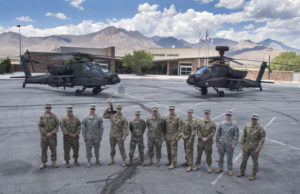
By Maj. Matthew Miskowski, Rotary Wing Aircraft Division, Aviation Test Directorate, U.S. Army Operational Test Command Public Affairs
INYOKERN, California – Thirty of U.S. Army’s finest accomplished the Follow-on Test (FOT) of the AN/APR-39D(V) Radar Signal Detecting Set (RSDS) here, both increasing unit readiness and informing acquisition fielding decisions for the Army.
Bearcat Co., of the 1st Attack Reconnaissance Battalion, 101st Combat Aviation Brigade, planned their war fighting missions in a hangar at the Inyokern public use airport, co-located with four Apache attack helicopters.
Each of the 16 attack and reconnaissance missions were conducted on the Electronic Combat Range (ECR) at Naval Air Weapons Station (NAWS) China Lake, California.

(Photo by Tad Browning, US Army Operational Test Command Public Affairs)
The ECR is a great training facility and test location, according to Larry Hood, an Aviation test officer from U.S. Army Operational Test Command (OTC), based at Fort Hood (Now designated Fort Cavazos), Texas.
Hood suggests units to consider the ECR for future training opportunities.
Scott McLendon, a retired Chief Warrant Officer 5 Apache pilot serving on the test as an OTC Aviation operations officer, reflected on the opportunity given to 1-101 ARB and the rest of Army Aviation.
“This training would benefit all aviators in the Army,” he said. “This test has given the Bearcat Co. an opportunity that other units will likely not experience, to exercise and perfect their tactics, techniques and procedures against real world threats, and not worrying about being shot down while they perfect their aviation skills against those threats.”
The six Bearcat pilots planned, briefed and executed assigned missions according to operational vignettes that either represented threats as autonomous or an integrated air defense system.

Additionally, Lt. Col. Scott Kruse, also an Apache pilot serving as the Rotary Wing Aircraft Division Chief, said, “Bearcats will be the Army’s experts at using the AN/APR-39D(V)2 for detecting and reacting to radio frequency (RF) threats.”
During the 15 days of test, data was collected to support the analysis of the operational effectiveness, suitability and survivability of the AN/APR-39D(V)2 for the materiel-release decision in fourth quarter fiscal year 2018.
The AN/APR-39D(V)2 RSDS’s next significant events are the cybersecurity testing and log demonstrations, to occur prior to a fielding decision in fiscal year 2018.
~~
As the Army’s only independent operational tester, OTC tests and assesses Army, joint, and multi-service war fighting systems in realistic operational environments, using typical Soldiers to determine whether the systems are effective, suitable, and survivable. OTC is required by public law to test major systems before they are fielded to its ultimate customer — the American Soldier.







